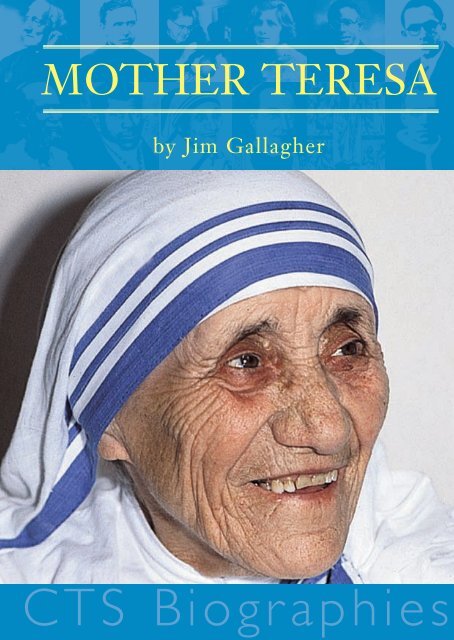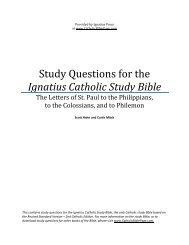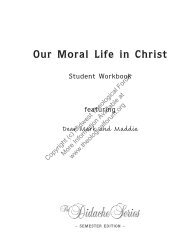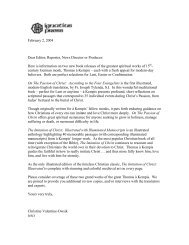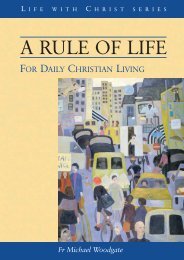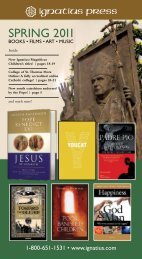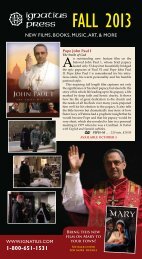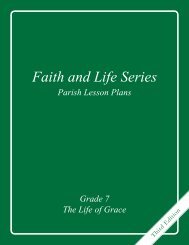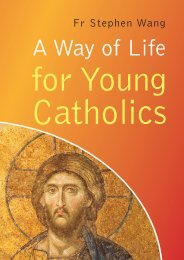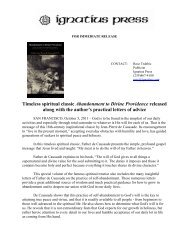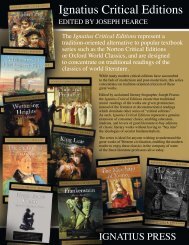Create successful ePaper yourself
Turn your PDF publications into a flip-book with our unique Google optimized e-Paper software.
Catholic Truth Society PublicationsDistributed by <strong>Ignatius</strong> <strong>Press</strong>Catholic Truth Society and <strong>Ignatius</strong> <strong>Press</strong> have joinedforces to make <strong>CTS</strong>’s outstanding booklets available in NorthAmerica. <strong>CTS</strong> booklets explain the faith, teaching, and lifeof the Catholic Church. They are based on Sacred Scripture,the Second Vatican Council documents, and the Catechism ofthe Catholic Church. These booklets provide authenticCatholic teaching; they address issues of life and truth whichare relevant to all. They aim to inform and educate readers onthe many issues that people have to deal with today.www.ignatius-cts.comAll rights reserved. Copyright © 2003, The IncorporatedCatholic Truth Society of London. Distributed in NorthAmerica by <strong>Ignatius</strong> <strong>Press</strong>, San Francisco, CA.ISBN 978 1 86082 189 9Front cover image: Copyright © Carlos Reyes-Manzo/Andes<strong>Press</strong> Agency. Page 14 courtesy of www.motherteresacause.info.Page 62 courtesy of Jim Gallagher.
CONTENTSIntroduction ....................................................................3Early Years and Family Life .........................................5Sister Teresa, Loreto Nun ...........................................17Mystical Experiences andFounding a Congregation ............................................27The Long Dark Night:Mother’s Interior Desolation ......................................58Final Years ....................................................................72Bibliography .................................................................77
3INTRODUCTIONFor decades she had been known quite simply as Mother.When, just five and a half years after her death, PopeJohn Paul II approved two decrees issued by theCongregation for the Causes of Saints, her ‘daughters’ theMissionaries of Charity issued a celebratory statement.“Today, after three and a half years of investigationand study, the Church confirms that Mother heroicallylived the Christian life and that God has lifted her up asboth a model of holiness and an intercessor for all.“Mother is a symbol of love and compassion. WhenMother was with us, we were witnesses to her shiningexample of all the Christian virtues. Her life of lovingservice to the poor has inspired many to follow thesame path. Her witness and message are cherished bythose of every religion as a sign that ‘God still lovesthe world today’.”From May 1998 Monika Besra, a thirty year-oldwoman from Bengal was being treated for TB. FromMarch of that year, however, a swelling had begun in herabdomen. By the time an ultrasound scan was performedon 8th August, the doctors could report a tumourequivalent to the size of a foetus of “about 24 weeks ofsize”. Due to Monika’s continued TB and poor generalcondition, the doctors advised against operating at that
4M OTHER T ERESAtime. By now she was being cared for by Missionaries ofCharity in their house at Patiram.Monika later testified to a Diocesan Enquiry that on themorning of 5th September 1998 she had joined other patientsfor special prayers in the home’s chapel for the firstanniversary of Mother’s death. She said, “I felt a ray of lightfrom Mother’s photo coming to me. I was frightened and myheart started to beat faster. After that I felt lighter but my painin the abdomen was there. All this happened in the morning.“In the evening, around 5pm when I was in the ward, SrBartholomea, Sr Ann Sevika and Habil Handsa (a helper ofthe Sisters) came to pray over me. Sr Bartholomea gave amedal and put it on my stomach and prayed over me. Thattime I felt lighter and pain lessened and I fell asleep.“At night, around one o’clock, I woke up as usual andI was feeling lighter and with no pain. I touched myabdomen. I could not find the tumour. I informed mybedside neighbour, ‘See, I am feeling lighter and there isno pain and the tumour has gone’.”It was to the findings by the various commissions that thiswas indeed a “miracle obtained through the intercession ofthe Servant of God, Mother Teresa of Calcutta” that PopeJohn Paul II gave his approval on 20th December 2002.It was announced that the Beatification of Mother Teresawould take place in Rome on Mission Sunday, 19th October2003, the closest Sunday to the 25th anniversary of the HolyFather’s Pontificate and the end of the Year of the Rosary.
5EARLY YEARS AND FAMILY LIFEWhen she died in September 1997, presidents and princesfrom around the world flocked to India to attend her funeral.They were representing their governments, their countries,their peoples - to pay tribute to the small stooped womanwho had become one of the most recognised faces on theplanet. Her name, Mother Teresa, had become synonymouswith goodness, kindness and a life of mercy and charity.The woman who during her life had been honoured bycountries from the Soviet Union to the United States,hailed from Albania in the south-east of Europe.When she was born in Skopje (later to become part ofSerbia) on 26th August 1910, her parents gave her thebaptismal name of Agnes. She was the third child born toNikola and Dranafile Bojaxhiu, having an elder sisterAge, and an elder brother Lazar.As a child she was plump and round and tidy and herfamily usually referred to her by her middle name ofGonxha, which in Albanian means ‘flower bud’.Prosperous FamilyWhen Agnes Gonxha was born, her family lived in verycomfortable circumstances. Her father Nikola, known asKole, was a successful entrepreneur. He had threedifferent business partnerships: with a doctor friend he
6M OTHER T ERESAhad opened up a pharmacy/chemist shop in Skopje; thenhe collaborated with a builder and their company wasresponsible for building the first Skopje Theatre, amongother things. His third successful business was inpartnership with an Italian man, importing luxuryproducts and foodstuffs into Albania.This business would sometimes take Kole away fromhome to other countries on buying trips. He spoke fivelanguages. Agnes’ brother Lazar remembered in later lifehow joyful were his father’s homecomings and great thedelight of the three children at the different gifts hewould bring them.The children also noted how, even when he was workinglocally, every day their mother Drana would change herdress and fix her hair for her husband’s return from work tothe family home for their evening meal and family Rosary.Kole was a member of the Town Council of Skopje. Healso played regularly in the town’s brass band and lovedto sing too. Their house was very comfortable and had anice garden. The family also owned the house next door.They lived just down the street from the local Catholicchurch of the Sacred Heart. Catholics formed only 10 percent of the Albanian population and the Bojaxhiu family’sreligious and social life centred around the lively parish.Dranafile was quite a bit younger than her husband andmarried in her teens. They loved each other dearly. Dranawas a good and conscientious homemaker. She was also a
E ARLY Y EARS AND F AMILY L IFE 7devout and pious Catholic. Most mornings she took herthree children with her to Mass at Sacred Heart church.Kole was considered quite progressive as he insistedon giving his daughters as well as his son a fulleducation. The three children attended primary school inthe parish halls of Sacred Heart church. Classes wereconducted in Albanian and then in their final year inSerbo-Croat, the language which would be used whenthey went on to the state-run secondary school.Early ‘love for souls’In later life Agnes was to write, “From childhood theHeart of Jesus has been my first love.” On making herfirst Holy Communion she seems to have received aspecial grace from Him. As an adult she remembered, asshe wrote in a letter, “From the age of five and a halfyears, when I first received him, the love for souls hasbeen within. It grew with the years.”This “love for souls”, for the whole person, was alsoeasily absorbed from her mother and father. When Kolehad to go away on a business trip he would ensure that heleft Drana not only enough money for the family budgetbut also extra to ensure that she would be able to feedanyone who came to their door in need.Indeed there were so often strangers at the table thatthe young Agnes was to remember in later life that shejust thought they were relatives come to share the family
8M OTHER T ERESAmeal. It was only much later that she realised that hermother was in the habit of feeding and clothing completestrangers and treating them as one of her own.But Drana did not only wait for those in need to knockat her door. If she heard of anyone sick or suffering shewould make her way to them. Lazar remembered that itwas most often Agnes who accompanied their mother onthese missions of mercy. In later life Agnes particularlyremembered helping her mother to wash a poor alcoholicwoman who was covered in wounds. She alsoremembered going with her mother to visit a youngmother of six children who was dying of cancer.In 1908 the Young Turks took power and by 1910 theywere insisting on the use of the traditional Arabic alphabet.The Albanians organised massive popular rallies in favourof the Latin alphabet. In March 1910 a popular revoltagainst the paying of taxes on imported goods to Istanbulspread very quickly. A 20,000-strong army crushed thisbrutally. In August of that year, after thousands of terrifiedAlbanians had fled as refugees from a new reign of terror,the Ottoman forces took direct control of the region.During the following year this war plunged thousands ofAlbanian families into poverty and illness.In 1912 when the Balkan States formed an alliance todivide among themselves the Ottoman possessions inEurope, the Albanians found themselves forced tosurrender their neutrality and fight on the side of the
E ARLY Y EARS AND F AMILY L IFE 9declining Ottoman Empire. Soon Skopje was underSerbian occupation.Thus even before the outbreak of the First World War,the young Agnes and her family experienced the bitterfruits of racial, ethnic and religious rivalry. At the end ofthe Second World War Agnes would once again witnesssuch hatred and inter-ethnic violence, albeit in anothercountry and another continent.The end of the ‘Great War’, the ‘war to end all wars’in 1918 only renewed the debate about the new borders ofthe Balkans. And very shortly the comfortable existenceof Agnes and her family would come to an abrupt end.Her father Kole was a passionate defender of Albanianindependence. He joined a movement which wanted to keepthe province of Kosovo, inhabited mostly by Albanians, inthe Greater Albania. In the end, the new federation of Serbs,Croats and Slovenians - known from 1929 as Yugoslavia -received most of northern Albania, including Kosovo.But in 1919 Kole was still arguing his case and eventravelled the 160 miles from Skopje to Belgrade to attenda political dinner on the subject. When he arrived backhome he was clearly a sick man. It was generally believedthat he had been poisoned. Seeing the poor state he wasin Drana despatched Agnes to fetch the parish priest. Atthe presbytery of Sacred Heart parish she was told thatthe priest had gone out. The child ran to the railwaystation hoping to find him and instead spotted a priest she
10M OTHER T ERESAhad never seen before. She ran up to him and explainedthat her father was very ill indeed. The priest immediatelyleft with her for the Bojaxhiu house and administered theLast Rites to Kole. The family rushed Kole to hospitalwhere he was operated on the next morning. Thefollowing day, however, he died.Speaking in 1982 Agnes’s brother Lazar said, “Ourfamily’s suffering began at the time the Yugoslavs and theAlbanians fought for Kosovo and the other Albanianprovinces, among which included the city of Skopje. Ourfather was very active in politics and very concerned aboutthe national Albanian issue. He tried to obtain national rightsfor the Albanians and he tried with all his heart to conservethe unity of the Albanian territories of Yugoslavia withAlbania. Once Yugoslavia took control of the territories thefamily was persecuted and my father was poisoned.”Massive crowds attended the funeral of NikolaBojaxhiu, including an official deputation from City Hall.He was known as a just and sincere man and a greatbenefactor of the area. On the day of his funeral all thejeweller shops closed as a mark of respect. The childrenin the local schools were issued with a commemorativehandkerchief to mark the day.After Kole’s death, a business partner appropriated theassets of his business and the family was left with only thehouse they lived in. The loss of her husband for a timeparalysed Drana with grief. She relied heavily on her
E ARLY Y EARS AND F AMILY L IFE 11children, particularly her eldest, Agnes’s big sister Age, towhom she even temporarily entrusted the keys of the house.Hardworking MotherBut Drana also now had to support her family, nine yearoldAgnes and Lazar and Age. She was a hardworkingwoman and one of entrepreneurial spirit. She set up abusiness of handcrafted embroidery, moving on also tosell different types of cloth. The business furtherexpanded to include locally crafted carpets. Her sonLazar accompanied her to the textile factories and in laterlife remembered how impressed he had been when themanagers would seek her advice about which materialsand designs to use to increase their sales.The family home continued to be filled with thefriends of the Bojaxhiu children. As they were growingup the girls took a full part in school and parish life. BothAgnes and her elder sister sang in the church choir andwere also members of the Albanian Catholic Choir ofSkopje, which gave benefit concerts. Agnes had a finesoprano voice and was often called on to sing solo.Active TeenagerFamily and friends noticed that young Agnes neverwasted time. When she was not helping with housework,studying, or even tutoring her friends who needed helpwith their studies, enjoying social activities with friends
12M OTHER T ERESAand taking part in parish activities, she would have herhead in a book, an avid reader.A young Jesuit priest, Fr Jambrenovic, had set up aparish library. He became parish priest in 1925 andseemed to have a great rapport with the young people ofhis parish. He set up for them the Sodality of the BlessedVirgin Mary and the youngsters were challenged by thewords of the Jesuit founder St <strong>Ignatius</strong> Loyola: “Whathave I done for Christ? What am I doing for Christ? Whatwill I do for Christ?” The young people were encouragedto serve Christ in His poor.They also learned about the lives of saints andmissionaries. It was possibly via the parish library thatAgnes first learned about and was exposed to the writingsof the young French Carmelite nun who was canonised in1925: St Thérèse of Lisieux. In 1927 the young saint wasdeclared patroness of missionaries.That same year in far-away India, Mohandas Gandhisuggested to the Christians in India, “... start at the bottom... In a word, ... go to the people not as patrons, but as oneof them, not to oblige them, but to serve them and workamong them.” Little could he have known that in a farflungcorner of south-eastern Europe there was a youngAlbanian girl who would one day be revered as India’sgreatest citizen alongside Gandhi himself!But all that was far in the future. In 1927 in SkopjeAgnes and two of her friends were receiving mandolin
E ARLY Y EARS AND F AMILY L IFE 13lessons from a second cousin of the Bojaxhius’. His namewas Lorec Antoni who became a well-known musician andcomposer. He directed the mandolin orchestra and gaveAgnes and her friends lessons without ever thinking ofcharging for this service. Agnes told him that if he didn’twant the money he should at least take a dinar from each ofthe girls and she could send it to the missions in India! Forthe youth group, the Sodality of the Blessed Virgin Mary,heard lots about the various Jesuit missions from theiryoung pastor. Agnes loved to read the magazinepublished by the Association for the Propagation of theFaith called ‘Catholic Missions’.Young Catechism TeacherAgnes, like all her family, was very involved in the lifeof Sacred Heart parish. She often acted as interpreterfrom Serbo-Croat to Albanian for the priest. As well asgiving lessons to those of her classmates who neededtuition in various subjects, she taught catechism class tothe little ones of the parish. This, and her ‘love for souls’seems to have instilled in her a great love of teachingwhich would mark her future life.Friends of the time remembered that on socialgatherings such as picnics (when they would sing as theymade their way into the countryside on horse-drawncarts) or at other get-togethers, Agnes would always carrya notebook with her. Sometimes she would read to them
14M OTHER T ERESAYoung Agnes Bojaxhiu before she left home and family to enterreligious life.
E ARLY Y EARS AND F AMILY L IFE 15some of the poems she had written. She also had a coupleof articles published in a local newspaper, ‘Blagovest’.Her cousin Lorenc Antoni was convinced that she hadtalent and could have made it as a writer.Fr Jambrenovic had helped the young members of theSodality to organise little prayer groups to pray for themissions. The ‘Call’ was becoming more insistent withinAgnes’s heart. At first it seems that she did not want tobecome a nun and leave her family. Her love was forteaching and she enjoyed particularly teaching the Faithto the little ones of the parish. She later said that she hadknown from the age of twelve that she wanted to dedicateher life to God in some way.How to know a vocation?Her cousin Lorenc remembered that Agnes wonderedhow you could know if God was calling you and even ifyou could know? He also remembered that FrJambrenovic spoke of vocation in terms of joy. If Godwere calling you, you should feel deep joy at the thoughtof serving God and neighbour within this vocation. In1927 and 1928 Agnes spent longer times than usual onretreat at a well-known Marian shrine in the region.Approaching her 18th birthday, she went there for the lasttime on the Feast of the Assumption, 15th August, 1928.Having discerned her call, Agnes Bojaxhiu did not holdback. As she said later, “I wanted to be a missionary. I
16M OTHER T ERESAwanted to go out and give the life of Christ to the people.”Priests from the same Jesuit province as Fr Jambrenovicwere working in Bengal. They wrote that sisters fromanother international order had been working in the area forsome time. They were sisters of the Institute of the BlessedVirgin and were of the Irish branch of that community.Agnes would apply to join them and contact was madewith the motherhouse in Rafthfarnham, Dublin.When she told her mother of her decision, Drana, wellaware that it would mean she would never see her daughteragain, could not come out of her room for twenty-fourhours. When she did emerge, once more composed, shetold her daughter, still not quite eighteen, “Put your hand inHis hand and make your entire journey with Him.”On 1st September 1928 Albania became a monarchyunder King Zog I. Agnes’s brother Lazar, now 21, hadbeen made a lieutenant and was to become an equerry tothe king. When Agnes wrote to him to congratulate him,and also to tell her of her decision to enter religious lifefor the missions in India, Lazar was understandably upsetand wrote back asking how a lovely young girl like hercould give up everything and go so far away, probablynever to see him and the rest of the family again?In her reply Agnes wrote one sentence which Lazarremembered word for word for the rest of his life. “Youwill serve a king of two million people,” she wrote. “Ishall serve the king of the whole world.”
17SISTER TERESA, LORETO NUNFarewell to SkopjeIn September her young friends of the Sodality and of thechoir put on a concert, part of which was a farewell toAgnes Gonxha Bojaxhiu. On the 25th of September, theevening before her departure, all her friends gathered atthe Bojaxhiu house to bid their last farewells. The nextday Agnes set out with her mother and her sister Age forthe train journey to Zagreb. As she waved goodbye to allher friends gathered on the platform as the train sped off,tears streamed down Agnes’s face.At Zagreb they met another girl, Betike Kanjc, whoalso wished to join the Loreto Sisters and Agnes madeher heartbreaking departure from her mother and sister.The two girls were to present themselves at the Loretohouse in Paris. There, with the aid of an interpreter fromthe Yugoslavian Embassy, they were interviewed by themother superior. From there they were sent to the ‘motherhouse’ of the Irish Loreto Sisters. Arriving there at theend of September, they spent six weeks studying English.In mid-November they set sail for India. On the sevenweeksea voyage there were also three young Franciscansisters. Christmas 1928 was spent on board ship and thefive young women made a Christmas crib. At the end of
18M OTHER T ERESADecember the ship docked at Colombo and like the otherpassengers, the young religious visited the city. On reembarkingthey discovered that a priest had joined theship and from then on they would have Holy Mass everyday. Sister Agnes wrote in a letter, “May God be praised;we began the new year with a sung Mass, which seemedto us a bit more majestic than low Mass.”Encounter with povertyThe two novices came ashore at Madras and wereimmediately struck by the poverty of the people. As SrAgnes wrote home, “If our people could only see allthat, they would cease to complain about their troublesand give thanks to God for having blessed them withsuch abundance!”On the 6th January 1929 they went up the RiverHooghly as far as Bengal, where a group of Indian sisterswas waiting to welcome them. Sister Agnes wrote home,“With an indescribable joy we stepped onto Bengali soilfor the first time. At the convent we first of all gavethanks to the Redeemer for having allowed us to arrivesafe and well at our destination. Pray that we mightbecome good and courageous missionaries.”After just a week in Calcutta, capital of the Bengalprovince of India, the young Sisters Agnes and Betikewere sent to the Loreto Sisters’ novitiate house, 450 milesaway, in Darjeeling.
S ISTER T ERESA, LORETO N UN 19Along with her religious formation, Sister Agnesstudied Hindi and Bengali, as well as perfecting herEnglish. In the mornings the novices taught the boysand girls in the Sisters’ adjoining school. Agnes alsosometimes worked in the little clinic run by the Sisters.She wrote, “The tiny verandah is always full of sickpeople, poor and suffering. All eyes are fixed on us,full of hope ...”According to her friend and biographer in later life,Eileen Egan, it was during this period that Sister Agneswas exposed to the life and writings of Thérèse Martin,the young French Carmelite nun who was canonised as StThérèse of Lisieux.First VowsOn 24th May 1931 Agnes Bojaxhiu made her first vowsof poverty, chastity and obedience as a Sister of Loreto,there in Darjeeling. She received the name in religion ofSister Teresa (spelt in the Spanish style as there wasalready a Sister M Therese Breen in the novitiate).In later life she would often stress that she was namedafter, “Not the big St Teresa, of Avila, but the little one.”(When I spoke to her about this, I recalled the saying ofSt Thérèse of Lisieux that she would like a whole train ofsouls to follow after her, who would follow her ‘littleway’ of love. I asked Mother if her Missionaries ofCharity might be part of this train of ‘little souls’ in the
20M OTHER T ERESAlittle way of love? She smiled at me. The fact that sittingwith us was Mother’s responsible Superior of the MCs inBritain, Sister Marie-Celine, the name of one of StThérèse’s sisters, somehow only enforced the link!)Soon after this first profession of vows, Sister Teresawas sent to Calcutta where she would teach in one of theLoreto schools. She was assigned to the Loreto School inEntally, an industrial district in the east of Calcutta. Shetaught mainly geography and catechism, and later onhistory. Classes were conducted in English, in whichSister Teresa had become fluent. (In total, she wouldspeak five languages fluently; Albanian, Serbo-Croat,English, Bengali and Hindi.)Bengali TeresaAttached to the Loreto school of Entally, in the samecompound, was another school, St Mary’s. This wasstaffed by a native diocesan congregation of sisters, theDaughters of St Anne, who wore Indian saris, rather thanthe traditional western-style religious habits. Attended byabout three hundred girls from a variety of backgrounds,classes were conducted in Bengali. Soon Sister Teresa wasgiving classes there too. Some people referred to her as the‘Bengali Teresa’ to distinguish her from Sister M ThereseBreen. The Mother Provincial of the Loreto Sisters was theSuperior of the diocesan Daughters of St Anne. Sheentrusted these Sisters to the care of Sister Teresa.
S ISTER T ERESA, LORETO N UN 21In 1935 Teresa was asked to teach also in anotherBengali school, St Teresa’s, a distance away from themain complex of the Loreto and St Mary’s schools.While she was permitted to leave the enclosure tojourney between these different schools, Sr Teresa wasotherwise bound by the strict policy of ‘cloister’. By allaccounts, she was an extremely popular teacher, whom thegirls loved. One former pupil remembered, “Her classeswere wonderful; she seemed to make the subjects comealive for us.” At Entally, many of the older girls were partof the Confraternity of the Blessed Virgin Mary, as theirteacher herself had been while a young girl back in Skopje.As the girls discussed the links between those who hadmuch and those who had very little, they eventuallydecided that they would like to visit poor families living inthe surrounding slums and the patients in a nearby hospital.Their favourite teacher encouraged them and spoke of thejoy of forgetting self and working at the service of others.She could not, however, accompany the girls on theirvisits. She was, remember, bound by the rule of cloister.Final VowsSister Teresa returned to her former novitiate each year tomake her annual retreat. There, on 14th May 1937 shemade her final vows as a Sister of Loreto. Six monthslater she wrote of that event to Fr Jambrekovic at home inSkopje, “If you would know how happy I was. Of my
22M OTHER T ERESAfree will I could have set on fire my own holocaust ... Iwant to be only all for Jesus ... I would give everythingfor Him, even life itself.”In time Sister Teresa was also made Headmistress of StMary’s School. While she was confined (apart from thejourney to and from St Teresa’s school) to the Loretocompound at Entally, she was far from unaware of thesuffering of so many Indians around her in Calcutta. (Infact, it seems that because of the serious situation, she wasallowed to accompany the girls of the Confraternity in someof their visits to the slums and the hospital from 1941.)During the Second World War there occurred theinfamous Bengal Famine. Official figures from theUniversity of Calcutta put the number of victims at threeand a half million. Devastating floods and a cyclone haddestroyed the rice crop.Calcutta was flooded by a tide of starving refugees. AsSister Teresa was teaching the girls at Loreto and StMary’s, the poor displaced, who were literally living onthe streets, were queuing at the city’s soup kitchens. Somany were those who died that the smoke from thefuneral pyres hung continually over the city.As part of the British Empire, India, whether it liked itor not, was involved in the War. Calcutta increasinglybecame a city ready for war as Japanese troops built up inneighbouring Burma. The entire Entally complex wasrequisitioned by the British Army as a military hospital.
S ISTER T ERESA, LORETO N UN 23The girls’ dormitories became hospital wards. The Sistersevacuated most of their charges to other convents andconverted hotels throughout the province.Sister Teresa, though, as headmistress and the sisterresponsible for the Daughters of St Anne, remained inCalcutta. She oversaw the removal from Entally to abuilding on Convent Road in Calcutta. She continued toteach geography, catechism and history, and alsoEnglish. It was at this time that she met the BelgianJesuit priest Father Celeste Van Exem, who wouldbecome her spiritual director.Extraordinary Private VowAt the end of 2002, the Postulator of Mother Teresa’sCause published information about a key event inMother’s life which took place in 1942. It was in thenature of a ‘private vow’, made with the permission ofher spiritual director, and would remain secret untilMother referred to it again in 1959 - in relation to thefounding of her Congregation - to a priest and to theArchbishop of Calcutta.Towards the end of her annual retreat in 1942 thethirty-two-year-old Loreto nun, as she later explained it,“wanted to give Jesus something very beautiful ...something without reserve”. In accord with her spiritualdirector, Sister Teresa bound herself “to give to Godanything that He may ask - not to refuse Him anything”.
24M OTHER T ERESAThis longing by the still-young woman to give her all,to express in some way her desire to hold nothingwhatsoever back from God, was surely divinely inspiredand was part of what lay ahead. As we shall read, theGood Lord, it seems, would refer to it Himself whencalling Sister Teresa to leave the security of life in Loretoand ‘put out into the deep’.Day of the Great KillingIn 1946 another disaster struck Calcutta, this time a manmadeone. British rule was approaching its end. Tensionswere high amid the debates about a possible futureHindustan and Pakistan. Bengal threatened to declareindependence. The Muslim League declared Friday 16thAugust as a ‘Direct Action Day’. Three days before theevent, possibly in the hope of averting clashes betweenthe different communities, the Muslim leader of theCalcutta Corporation declared that the 16th would be apublic holiday so that people did not have to go to work.The Muslim League convened a mass rally inCalcutta’s great park, the Maidan. The day was hot, with atemperature of 31 degrees celsius - and a humidity rate of91 per cent. As the meeting broke up, Direct Action Dayerupted into horrendous inter-community violence inCalcutta. It turned into a frenzy of carnage and slaughterand destruction. On both sides, Muslim and Hindu, peoplewere burned alive, slashed to pieces, beaten to death.
S ISTER T ERESA, LORETO N UN 25The military were called in on the Saturday to put anend to what had become a bloodbath. The streets ofCalcutta literally ran with human blood, the drainsbecame blocked with human body parts. For some daysthere were eruptions of further violence throughout thecity. Normal human activity ceased. There was onlydeath and destruction.During those days at least 5,000 people were killed inCalcutta, and at least another 15,000 wounded. Over100,000 people fled the city and within the city itselfanother 100,000 were displaced.There were no shops open or deliveries of food or goods.Here was a time if ever there was one when the normalrule of cloister had to give way to necessity.Mother Teresa later related to Eileen Egan, “I went outfrom St Mary’s, Entally. I had three hundred girls in theboarding school and we had nothing to eat.“We were not supposed to go out into the streets, but Iwent anyway. Then I saw the bodies on the streets, stabbed,beaten, lying there in strange positions in their dried blood.“We had been behind our safe walls. We knew thatthere had been rioting. People had been jumping over ourwalls, first a Hindu, then a Muslim.“You see, our compound was between Moti Jihl,which was mainly Muslim then, and Tengra, with thepotteries and tanneries. That was Hindu. We took in eachone and helped him to escape safely.
26M OTHER T ERESA“When I went out on the street - only then I saw thedeath that was following them.“A lorry full of soldiers stopped me and told me I shouldnot be out on the street. No-one should be out, they said.“I told them I had to come out and take the risk. I hadthree hundred students who had nothing to eat. Thesoldiers had rice and they drove me back to the schooland unloaded bags of rice.”It was perhaps not the first, and certainly not the lasttime that Sister Teresa would take a risk, even to her ownlife, for the sake of others’ needs - to find that Providenceprovided her with exactly what was required.As the violence subsided and eventually died awayafter some days, vultures were feasting on human remainsin the streets of Calcutta. Once again, the smell of smokefrom human flesh hung over the city as the thousands ofcorpses were cremated in the traditional burning ghats.The event became known as the Day of the GreatKilling and thereafter, whenever Mother Teresa referredto it, her face would cloud over with the deepest sadness.
27MYSTICAL EXPERIENCES ANDFOUNDING A CONGREGATIONThroughout Mother Teresa’s long life, whenever shewas asked about her decision to leave the Loretocongregation to found a new religious community, heranswer was always the same, practically word for word.This lucidity and simplicity we will also see in herdealings with the ecclesiastical authority, theArchbishop of Calcutta.For in whatever concerned those momentous eventsthat would lead to the creation of a worldwide network ofcentres of Christian charity, thousands of womendedicating their lives to Jesus “in the poorest of the poor”and herself becoming the most famous woman on theplanet, the details were seared in the mind and heart andsoul of Mother Teresa.Whenever she was asked if the experiences of theDay of the Great Killing were what propelled her toleave the security of Loreto to work with the poor ontheir streets and in their hovels, she was quite clear. No,it was not.The very first words of the Constitutions of her newreligious family are a quotation from St John theEvangelist. “You have not chosen me but I havechosen you.”
28M OTHER T ERESAAs she repeated in many interviews in later years, shewas on the train to Darjeeling to make her annual retreatas usual, on 10th September 1946. “It was on that trainthat I heard the call to give up all and follow Him into theslums - to serve Him in the poorest of the poor. I knew itwas His will and that I had to follow Him. There was nodoubt that it was to be His work.”Let us recall that this was a person who had been closeto Jesus since her childhood. She would later write to theArchbishop of Calcutta, “From childhood the Heart ofJesus has been my first love”.At the age of eighteen she had clearly discerned herown vocation to the religious life and followed thatresolutely at the cost of abandoning her homeland and thelikelihood of ever seeing her mother again.Writing of her years in religious life in Loreto, shecould honestly say, “I have tried to live up to Hisdesires. I have been burning with longing to love Himas He has never been loved before”. At the age ofthirty-two, having been a religious sister for fourteenyears, she felt the call, and received permission toanswer it with a private vow, “to give to Godanything that He may ask - not to refuse Himanything”. The sensitivity of such a woman to thewill of God and the ‘still small voice within’ her mustsurely be heightened.
F OUNDING A C ONGREGATION 29‘It was an order’For her part, the event that she described as “a callwithin a call”, on the train to Darjeeling, was perfectlyclear and straightforward. “The message was quiteclear,” she explained. “I was to leave the convent andwork with the poor while living among them. It was anorder. I knew where I belonged, but I did not know howto get there.”She would submit everything to her spiritual director,and through him to the discernment of the legitimatelyappointedsuccessor to the Apostles, her Local Ordinary,the Archbishop of Calcutta.When she returned from retreat, Sr Teresa informedFr Van Exem of what had happened - not so much inwords but as he recalled, with “a whole sheaf ofpapers”, notes she had made on retreat. Everything wasclear and precise. The Lord wanted a newcongregation. Indian sisters who would wear a simplesari. They would live among the poor and give freeservice to the poorest of the poor. They would not bebound by cloister but would go out, in pairs, to serveChrist in His poor. Girls who would join from othercountries must become ‘Indian-minded’ and dress insimple saris and sandals. The sisters should learn howto ride bicycles in order to reach the people where theyare in need. Some would need to learn to drive buses.The sisters would be called Missionaries of Charity.
30M OTHER T ERESAFrom the initial train journey, throughout thatretreat of 1946, everything was made clear to SisterTeresa, not without some fear and trepidation on herpart. Fr Brian Kolodiejchuk, MC, Postulator ofMother’s Cause for Beatification, has revealed thatduring that retreat she had several locutions andinterior visions.On hearing all this Fr Van Exem exercised his pastoralrole of discernment too. He tried to ‘cool off’ SisterTeresa and her enthusiastic and detailed plans. Aftersome months he concluded that it seemed that theinspiration was really a call from God. He spoke toArchbishop Perier about it in December 1946.‘Year of Waiting’The archbishop decided that no decision should be takenfor a year.This formal ‘year of waiting’ would begin on 1stJanuary 1947, which happened to coincide with thebeginning of Indian independence.When Mother Superior of Loreto at Entally wasinformed that Sr Teresa was about to embark on thisyear of discernment she transferred Sister, later thatJanuary 1947, to a Loreto convent in Asano, 130 milesnorth of Calcutta. There Teresa was placed in charge ofthe kitchen and the garden and was also allowed toteach geography.
F OUNDING A C ONGREGATION 31When the last British forces left India in August1947 and partition of the country began into MuslimPakistan and the majority-Hindu India there began agigantic displacement of populations; some sixtymillion people. Violence erupted, giving rise toanother bloodbath, claiming some one million victims.In a few short weeks some four million refugeesarrived in West Bengal.Sister Teresa continued teaching geography at Asanowhile managing the kitchen and garden.On 12th January 1947 Fr Van Exem gave Sister Teresapermission to tell the archbishop everything, to write tohim “as a daughter to her father, in perfect trust andsincerity, without any fear or anxiety...”The next day, while still at St Mary’s Entally, shewrote a long letter to Archbishop Perier.‘Wilt thou refuse?’She explained how since September 1946 and herannual retreat she had heard the insistent call of OurLord to do something new. She revealed the sufferingthis caused in her soul. “I have been and am very happyas a Loreto nun. To leave that which I love and exposemyself to new labours and sufferings which will begreat, to be the laughing stock of so many, especiallyreligious, to cling and choose deliberately the hardthings of an Indian life, to loneliness and ignominy, to
32M OTHER T ERESAuncertainty - and all because Jesus wants it, becausesomething is calling me to leave all and gather the fewto live His life, to do His work in India. These thoughtswere a cause of much suffering, but the voice kept onsaying, ‘Wilt thou refuse?’“One day at Holy Communion I heard the samevoice very distinctly, ‘I want Indian nuns, victims ofmy love, who would be Martha and Mary, who wouldbe so very united to me as to radiate my love on souls.I want free nuns covered with my poverty of theCross. I want obedient nuns covered with myobedience of the Cross. I want full of love nunscovered with the charity of the Cross. Wilt thou refuseto do this for me?’”As Fr Van Exem had advised, simply and with thetrust of a child speaking to her father, Sr Teresadetailed how each day this interior voice had becomemore insistent. And very rationally and honestly, sherecognised the fear that the requests being put to herprovoked in her very soul. “These words, or rather thisvoice, frightened me. The thought of eating, sleeping,living like the Indians filled me with fear. I prayed long- I prayed so much - I asked Our Mother Mary to askJesus to remove all this from me. The more I prayed,the clearer grew the voice in my heart and so I prayedthat He would do with me whatever He wanted. Heasked again and again.
End of booklet sample. Find more and order online:http://www.ignatius-cts.com/


